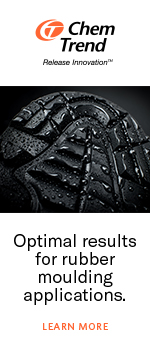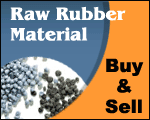|

|
|
IndiaRubberDirectory.com > Rubber Article |
Polyblends System
of Poly Urethane and H-NBR (Peroxide cure)
M. Maity, B.B. Khatua, S.R. Chowdhury & C.K. Das
Materials Science Centre
Indian Institute of Technology
Kharagpur-721 302, India
Introduction
Polymer blender are of growing industrial importance. Blending of polymers is an
attractive and echonomical method to create and develop new polymeric materials
with enhanced performance characteristics and improved properties than existing
polymers. The applications of poly urethane (PU) elastomers are in the wide
varieties of products. Millable branches of industry, including mechanical
engineering, textile and petroleum industry and motor vehicle constructions. The
combintion of extellent mechanical strength and abrasion resistance makes the PU
industrically important. On the other hand, H-NBR possesses a high resistance to
oxidative and ozone degradation, excellent tensile strength, and very good
abrasion resistance properties.
Experiments
Blends were prepared in an internal mixer at a constant speed for fixed period
of time by gradual replacement of polyurethane with H-NBR in the entire
composition range using DCP as the curative. Then the mixture were sheeted in an
open two roll mixer. Blends were allowed to cure in a hot press at temperature
1500C upto optimum cure under constant pressure. With the blends, following
tests were conducted. Physical Properties of the blends like hardness, modulus,
tensile strength, elongation at break etc. Were measured on cured sheets both
before and after ageing. Measurement of cure characteristics were carried out at
1500 C in a Monsanto Rheometer (R-100) in order to study the processibility,
cure mechanism and activation energy of curing etc. DTA/TGA of the blends were
studied by Shimadzu Thermal Analyser in air at the heating rate of 100 C/min
within the temperature range from Room Temperature to 6000 C. IR spectral
studies were also carried out to establish the interchain crosslinking if any.
The phase morophology was studied for extracted samples with the help of SEM.
Results and Discussion
Effect of H-NBR on the cure characteristics of the blends:
Polyurethane rich blend shows the maximum state of cure than that of the H-NBR
rich blend (as shown in figure 1). Modulus and Hardness are in line with the
state of cure as above. The tensile strength changed on ageing and the
percentage change increased with increasing H-NBR content. But elongation at
break was lost on ageing. The percent change decreased with increasing H-NBR
content.
IR Spectral Analysis:
The IR spectra of thin films of PU, H-NBR and PU/H-NBR (50:50) blend (without
any curatives) heated at 1500 C for 30 min are shown in the figure 2. PU shows a
broad peak at 1716 cm-1 for amide >C=0 stretching and at 3510 cm-1 for N-H
stretchings. In H-NBR there was a sharp peak at 2230 cm-1 for –CN group. The
blend showed were also peak at 2290 cm-1 for –CN group which clearly indicates
tha –CN group were not takes part in the reaction. The peak at 3510 cm-1 for N-H
stretching of PU was absent in the blend, suggesting the crosslinking. Occurs
through ‘N’ in PU with H-NBR. This also support from the presence of one
additional peak at 1520cm-1 in the blend (this peak probably due to the
crosslinked C-N stretching). Figure 3 shows a plausible mechanism for the
interchain crosslinking reaction between PU and H-NBR.
Thermal Analysis:
The degradation pattern of the PU/H-NBR blends has been studied. The DTA/TGA
plots are shown in figure 4 for PU/H-NBR blends.
From the DTA/TGA plots it was observed that the degradation occurs in three
steps. In the case of the blend with lower amount of H-NBR early degradation
occurs starting at 4100C. The second step starts step at 4900C whereas for the
blend with higher amount of H-NBR, the degradation is delayed and starts at
4500C. The second step, however, starts at 5000C.
SEM Study:
The Samples were DMSO extracted to remove the Phase and then the morphologies
were studied by SEM. It appears from the micrograph that PU has the tendency to
form continuous phase even at relatively lower percent content. At the middle
region, however, appearance of discrete particles are observed. Interchain
crosslinking enhances the phase adhesion.
Conclusion
The incorporation of H-NBR improves the ageing properties and heat resistance
properties of the blends. The blend properties largely on the blend ratio and in
the blending techniques. Heat treatment of the blends before adding curatives
enhances the properties due to the interaction crosslinking. Preheating is more
effective in case of Pu/H-NBR blends when peroxide curing system in used.
Reference
1. Utracki L.A., polymer Alloys and Blends, Hanser Publishers, London and New
York
2. Hepburn C., Polyurethane Elastomers, Applied Science Publishers, London and
New York (1982)
3. Singh Roy S.K. and Das C.K., J. Elastomers Plastics 27, 3 (1995) 239
4. Singh Roy S.K. and Das C.K., Polymers and Polymer Composites, Vol.3 No.6,
(1995)
5. Tripathy A.r., Ghost M.K. and Das C.K., Intern. J, Polymeric Matter, 17 (2),
77 (1992)
|


























